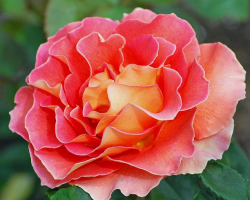List of means for feeding cabbage.
Content
- Do I need to feed cabbage?
- How to feed the cabbage for growth?
- Planting cabbage, how to feed?
- How to feed cabbage after planting in the ground?
- Cabbage: how to feed for growth in June?
- How to feed cabbage in August for growth?
- Cabbage is growing badly than to feed?
- How and how to feed cauliflower after landing?
- How to feed cabbage for the formation of a head
- How to feed cabbage for forking: reviews
- Video: How to feed cabbage?
Cabbage is a rather capricious culture that is distinguished by poor growth. That is why it is recommended to carry out processing not only during the transfer period under the open sky, but even at the stage of diving seedlings. In this article we will tell you how to feed cabbage.
Do I need to feed cabbage?
Many believe that the cruciferous in our conditions grow quite well, while giving large, dense forks that are ideal for salting and conservation. In fact, with the inappropriate composition of the soil, the culture refuses to grow.
Do I need to feed cabbage and when:
- The cruciferous go in color, while letting the arrow and buds. The taste worsens significantly, bitterness appears.
- The appearance of a large number of single, long, high leaves. Such a problem usually occurs in the case of a large amount of nitrogen. Some trace elements are very poorly absorbed if they are applied one at a time. We are talking about calcium. Together with them it is recommended to wear magnesium and potassium. It is believed that these components are well combined with each other, enhancing the action.
- Many gardeners with experience are advised to water iodine with a solution of iodine. About 40 drops are added to 11 liters of solution, this is about 2 ml of alcohol infusion. Such processing will get rid of pests, and will become a magnificent preventive tool that will prevent the appearance of aphids, ants, and other parasites.
Cross -stages do not like too sour soils, which is why it is recommended to alkalizing the soil twice a year. Usually make chalk, or unsuccessful lime. It is also recommended to use ash. However, such manipulations independently, without preliminary analyzes and determination of acidity, are not worth it, because you can achieve the opposite effect, and worsen the condition of the soil.

How to feed the cabbage for growth?
Gardeners believe that watering vegetables should be carried out by a “young”, that is, after the first bushes are formed, with 3-4 leaflets.
How to feed the cabbage for growth:
- After diving, within 10 days, when the bush becomes quite dense and strong, the first processing is carried out. For 1000 ml of water, a nutrient mixture is needed, consisting of 2.5 g of yamchug, 4 g of monocalcium phosphate.
- At the initial stage, even before transferring to the ground, the culture is usually treated with drugs containing a large number of nitrates. Before transferring to the ground, the growth of the first bushes is important. Only after the formation of the forks begins, the plant will need phosphorus, potassium.
- Before the origin of the head, it makes no sense to bother with such funds. After the first watering with nutrient components, repeated manipulation is performed. Only ammonium nitrate is introduced. About 4 or 5 g of Yamchug is diluted in 1000 ml. The product is introduced under the root.

Planting cabbage, how to feed?
Processing is carried out immediately before transferring bushes to open ground. It is necessary to dilute 2 g of potassium chloride into 1000 ml of water, add 4 g of yamchug there, and 8 g of monocal fosterfate.
Cabbage planting than to feed:
- The mixture is mixed and watering under the root. Now is the time to engage in organics. Gardeners are often watered with nutrient components since the fall.
- That is, during digging the garden, organic components are added, for example, compost, droppings. However, if you did not carry out appropriate manipulations in the fall, during digging, it's okay. You can make up for the deficiency of organic matter in the spring, before planting the bushes. In each fossa, it is worth adding a half -kilogram of compost or humus. It is worth adding a small amount of monocalcium phosphate and yamchug there.
- The mixture is mixed and introduced into the hole. The surface is covered with a substance, which consists of garden soil, and peat, which will make the earth more fluffy, and improves the passage of water, mineral components to the roots.
- If you think that the initial number of mineral additives was enough, it is allowed to make organics. It is worth it in every fossa before planting, pour a handful of humus or mullein. Further, two matchproofers of wood ash are introduced into each fossa. All this is embedded, mixed with the soil, and then the bush is planted. This reserve is enough for the shoots to start, and the seedlings take root well in a new place. This is a kind of deposit, or a reserve, to enable culture to grow at first.

How to feed cabbage after planting in the ground?
For the first time, nutritious irrigation is carried out after 10-15 days. It can be skipped if a nourishing pasta was used during landing. If not, nothing terrible happened.
How to feed cabbage after landing in the ground:
- During this period, it is worth adding nitrogen -containing components for the development of green mass. Urea, yamchug, wood ash, or organic matter, for example, mullein are suitable.
- 500 ml of fluid is enough to saturate the bushes with useful substances. Repeated processing after planting in the ground is carried out 10-15 days after the first. However, during this period it is recommended to add components that differ in composition from the first processing.
- Indeed, in this period of time the heads of heads appear, so the introduction of ammonia components can play a cruel joke. A large number of leaves will form, but in the end you will not get a dense head.

Cabbage: how to feed for growth in June?
June is a period of active growth of cruciferous. The main advantage is that there is a very long daylight day, and the active growth of all garden crops. Usually a large number of new sheets and ovaries of heads are formed.
Cabbage than to feed for growth in June:
- In June, it is worth watering with nitrogenous components, alternating them with organic additives. Watering with a nutrient mixture is carried out about once every 7-10 days.
- When the leaflets begin to connect with each other, forming a boat, it is worth rooting the tactics. During this period, culture needs complex mineral additives, they are alternated with organic components. During this period, nitrate compositions are no longer introduced, since there is no need to stimulate the growth of green leaves. Now is the main task- this is contribute to the tight adjustment of the leaves to each other.
- If in June you did not notice that the leaves begin to fold in boats, and do not form a dense head, it is worth changing care and watering, as well as the introduction of fertile mixtures. It is necessary to transplant bushes to a sunny place with a lump of earth.
- After all, if the culture grows in the form of a palm tree, without the formation of heads, then it does not have enough sunlight. Plant it to a place where direct sunlight is observed. It is possible to save the fork, and get a generous crop. It is worthwhile to water, but not nitrates, but with complex, mineral compositions. You can add a mullein.

How to feed cabbage in August for growth?
In August, the formation and beginning of the tie of heads in late varieties, which are collected in the fall, took place. Do not calculate that late varieties will differ in large heads. Most often this is not the case, the vegetable is ideal for the workpiece and sourdough.
How to feed cabbage in August for growth:
- As for the mid -season varieties, it is in August that heads begin to twist. The main task during this period, regardless of the variety, is to provide abundant watering. For red and white, you need 12 liters for each bush.
- The frequency of watering - once every three days, provided that the summer is not at all rainy and dry. During this period, nitrates are not used. In August, it is worth using compounds that contain calcium, magnesium, as well as phosphorus. It can beammofoska, or potassium agents. They are introduced after watering, dry. It is worth making additives under the root, having previously mixed with water. After watering is carried out, you need to loosen the soil. It is also allowed to mix with dry soil.
- To saturate with beneficial substances of kohlrabi, or cauliflower, it is worth reducing the number of components by half. The liquid must not be allowed to fall on the leaves and sockets. This can cause a chemical burn. If, nevertheless, the droplets hit the leaves, it is worth washing them with a large amount of water from the hose. Color cabbage in August 2-3 times treated with a mixed composition. One liter of mullein is diluted in 5 liters of water, and monocalcium phosphate is added. This mixture is watered by bushes at the rate of 2.5 liters per square meter.

Cabbage is growing badly than to feed?
There are several recommendations to fertilize seedlings in case of poor growth. If in the conditions of a greenhouse or at home seedlings develops quite poorly, it lacks mineral components, light or there are errors in watering.
Cabbage is growing poorly than to feed:
- It can be either an excessive amount of moisture and its disadvantage. To improve the condition of seedlings, dive in time in order to prevent the thickening of landings.
- On the 10th day after diving, it is worth adding potassium chloride, yamchug and monocalcium phosphate. Potassium chloride is required 1 g, yamchug 2.5 g, and monocalcium phosphate 4 g. This amount of bulk components is introduced in 1000 ml of water.
- On the 12th day after transferring to open ground, it is necessary to water with a solution that consists of a hole. It is worth adding 4 g of bulk substances per 1000 ml of water.

How and how to feed cauliflower after landing?
After the culture is transferred to the ground, it is worth introducing useful additives. The first portion should be added directly to the pits for planting.
How and how to feed colored cabbage after landing:
- In equal quantities, turf, humus, as well as peat are mixed. The mixture is averaged and filled with holes for planting seedlings. The next processing is carried out when two new sheets appear. During this period, the integrated composition will be useful.
- Mix yamchug, monocalcium phosphate, potassium in 10 liters of water. An approximate concentration of components should be 2: 3: 1. Repeated introduction is carried out after 2 weeks. Manure or compost is recommended. It is also recommended to water urea with a solution of urea. Dilute 30 g of grains into 10 liters of water and pour 500-700 ml of liquid under each bush.
- Experienced gardeners use wood ash. This is a kind of alternative to potassiums with potassium, zinc. The ash is bred in water and watered under the root. For color cabbage, fucked additives are recommended. 20 g of yamchug is diluted in 11 liters of water, and leaf processing is carried out.

How to feed cabbage for the formation of a head
In Russia, this culture is considered a queen among all vegetables, thanks to low cost, accessibility, and fairly decent taste. There are many ways by which you can accelerate the growth of culture, without the acquisition of special means.
How to feed cabbage for the formation of a head of head, folk recipes:
- Manureallows you to get large forks. Usually mix this substance with water in a ratio of 1: 5. It is added 2 weeks after transferring seedlings to the ground. Be sure after making the drug, mulch the soil around the bush. The second time manipulation is carried out before the forks are formed. After three weeks or a month, the cow is mixed with ash with ash. Recommended as an organic fertile composition of bird droppings. Usually it is mixed with wood ash. The ash is poured with boiling water, kept in a dark place, filtered and diluted with bird droppings.
- Well established itself herbal infusion. Weeds, which are a source of a large number of unnecessary plants that impede the growth of culture, can be used with benefit.
- Fill with mowed grass one third container. It can be a barrel or an unnecessary container. Pour water to the very edges, leave for about a week or two. A few drops of iodine can be added to this mixture. This will make the product more useful. The substance is watered in the period when the formation of a head begins.
- It is worth highlighting yeast. They contain a lot of amino acids, proteins that are needed for the active growth of plants. Apply beer orbakery kinds. 100 g of yeast is diluted with water, add 100 g of sugar. This is necessary to stimulate fermentation, and the growth of the colony of yeast. The mixture is diluted with water to 50 liters. After, pour 500 ml of the solution under each bush.
- A fairly effective foliar supplement is boric acid. Dilute 10 g into 1000 ml of water. It is worth taking hot water so that the dissolution process passes faster, more active. 1000 ml of fluid must be diluted in 11 liters of water. This tool should spray the heads. The drug does not accumulate inside the fruits, so it can be used several times during the summer. It is recommended to alternate organic components with minerals.

How to feed cabbage for forking: reviews
Reviews of gardeners will help you choose the best option for care.
How to feed the cabbage for the growth of forks, reviews:
Valentine. I live in a private house, at I have a small garden. I plant a large number of vegetables, and cabbage too. Since there is not much light on the site, the heads are small. Often for processing, growth stimulants, as well as monocalcium phosphate, are used. I also use special products that are sold in gardeners.
Denis. I grow cabbage on my site for several years. The heads are always large, and very dense. For irrigation, I use urea, monocalcium phosphate, nitrogen fertilizers. I spend four entry on the season. The first consists of organics, all the others are prepared from drugs containing phosphorus, nitrogen and magnesium. I prefer to use complex drugs. It turns out at a cost below folk remedies. No need to carry out 10 processing per season.
Veronica. In my country, fruit trees are mostly growing. Last year, I decided to plant a small garden with a salad, greens. The culture has grown large, I used complexes. I bought a mullein and bird droppings, got a good harvest.

We advise you to read the following articles from which you will learn how to grow:
The most difficult thing is to do with cauliflower, since the lack of sunlight provokes bitterness in inflorescences. She needs components with the content of boron and molybdenum. The procedure for the entire season is carried out once or twice. It is recommended to use Kemira, uniflor growth.







